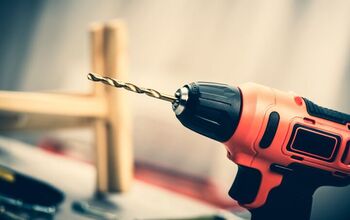Craftsman 19.2-Volt Battery Fix (We Have A Solution)

The Craftsman 19.2V drill can make for a lightweight, high-power, versatile drill. It is no wonder that thousands of craftsmen in the United States and around the globe add these to their tool benches. Even better, they come with a pair of lithium-ion batteries to ensure that you can keep working around the clock. But there are times where the batteries will stop holding a charge and won’t work the way they are meant to.
When the battery stops holding a charge and working the way that it’s supposed to, you can rebuild the battery and create a charger for the new battery. This involves cracking the case, and getting into the circuit board, so you will need to have the correct tools for the project.
This guide will show you how to fix the problem and get your craftsman drill working again the way that it was meant to so you can get back to the projects that need completing. The fix may even be applicable for other kinds of tools.
Why It’s Necessary To Fix Your Battery
When the batteries on the Craftsman 19.2V drill become defective, it may take a minute to notice. This is because the charger will have the green indicator light lit up solid. This is supposed to mean that the battery has a full charge.
The problem, however, is that there is no charge at all. And if you can’t take it back to the seller, you might feel like you are stuck with a dead battery. Thankfully, there is a fix that you can implement to get your Craftsman drill working optimally once again.
How Much Does It Cost To Replace The Battery?
Should you decide that you just want to replace your dead battery, that certainly is possible, but it will come at a cost. Like anything else that you purchase, it will depend on where you get it from, and you may trust one vendor over another.
Generally speaking, though, you can find them for as cheap as $34.99 depending on your model running as expensive as $64.99. The cost may be worth it to you if you aren’t experienced or confident enough to rebuild the battery on your own.
Keep in mind beforehand that you will need quite a bit of tools to get the job done, so if you need to stock up on tools, it may not be worth the cost if you are only doing this for the battery. If you think you may wind up needing the soldering iron in the future, though, it could be a worthwhile investment to pick it up, even if it isn’t just for this project.
Instructions For Rebuilding Your Battery
To rebuild your battery, you will need to get into the inner workings of it, which means you will need to have the necessary tools. While this is a relatively complicated project, the process itself is pretty simple. Make sure you follow the steps below slowly and accurately to ensure you do the job correctly.
Step 1: Acquire The Tools Necessary For The Job
With a little skill and some know-how (and this guide), you can rebuild the battery and get it working once again. First, you will need the tools for the job.
- #10 Torx bit/driver
- Scratch awl
- Wirecutter
- Wire stripper
- Needle nose pliers
- Hot glue gun
- Soldering iron
- Solder
- Solder wick
- Solder paste
- Black wire (4″ piece)
- Shrink tube
- 20v multi-output voltage laptop charger
- Insulated alligator clips (black/red)
When you have the tools, you can begin taking apart the battery, locating the problem, and implementing the fix.
Step 2: Crack That Case
The first step once you have all of the necessary tools is to get the case open. Use the aforementioned bit to get the four screws out. If you don’t have the last bit, you can use a scratch awl. Make sure that you use enough pressure to break the little pin off. It will be located in the middle of the screw head.
Depending on your case, it might take a couple of different angles before you are able to get the pin off. When you do, remove the screws, pop off the top of the case, and then, finally, take out the plastic locking tabs.
Step 3: Take Out The Circuit Board
For this step, pry the charging connector support up (it’s white and plastic) so that it is loose. Take out the small screws, usually four of them, that hold the circuit board in place. From here, you’ll need to cut all four of the thinner wires that are on the outer edge of the battery. There are three red ones and a blue one.
Next, cut the black wire located at the connector terminal of the charger while also cutting the red and blue ones that run into the connector terminal. Don’t cut the red wire that is opposite to the black one; cut it around the circuit board instead.
From here, you will desolder the tab where the battery connector is from the circuit board itself. Pry up the board and tilt it up, cutting the red wire at the bottom. Lastly, take the sponge tape off. This holds the thermal protector in place and lets you remove the board. Make sure that you separate the charger connector stand, too.
Step 4: Rebuilding The Battery
Now, set up your charge connector base back in the original spot, putting those two pins back into their holes. You can use the glue to fill in space and also to attach the other two legs so that the battery holder will stand upright.
Take the charge connector and strip the red wire as well as the other red wire that is in the battery pack itself. Take a piece of shrink tube, put it over one wire, and then solder both together. Make sure that you use the shrink tube to cover the joint, too.
Get your black wire and solder one end of that to your charge connector (this is where you cut the black wire earlier). Take the other end and solder it to the tab you desoldered earlier on the battery pack. This is all you need to do for inside work. Make sure that you put the tabs back into place. Lastly, snap the top of the case back and make sure that you line up the charge connector terminals properly before putting the screws back into place.
Step 5: Building The Charger
This is where that laptop battery charger comes into play. Depending on where you live, you can get one for as cheaply as $10-$20. They are generally pretty cheap and made for lithium batteries (which is what your Craftsman is).
It is essential that the charger have the recommended 20v output since these batteries are 19.2v. There is a chance that your charger will come with a two-pin connector setup that is wired to the multi-connector. You can simply cut the wires at the connector and put your insulated clips in the positive/negative spots. There’s a chance yours will be more complicated.
Step 6: Getting The Charger Ready
When you have finished setting up the charger, make sure that you have it set for the required 20v output. You can then connect your positive (red clip) to its corresponding terminal and do the same with the negative. For the positive, it will be on the round side of your charge connector; the black will be on the flat side. Give it about an hour to charge so that the battery will have some juice before you try it out.
Does The Charger Work?
If you have followed all of the steps correctly, the battery should work like it usually does. If the drill doesn’t respond to the battery, you may have missed a step somewhere; go back and check. But otherwise, you have just salvaged what you thought was a ruined battery and made it good as new.
Should You Purchase A New Battery Or Fix The One You Have?
While rebuilding your battery will save you on spending the money to buy a new one, there are some instances where it may be a better choice to buy a new battery instead. Signs that you may need to buy a new battery include:
- Swelling or bloating of the battery
- Leaking
- Burn marks or often overheating
If you experience any of these signs, you need to dispose of that battery immediately. This means that the battery is malfunctioning and is at high risk of exploding.
When Is It Okay To Rebuild The Battery?
If the issue is simply that your battery is not holding a charge, first, you will want to check your charger. Sometimes the problem lies within the charger instead of the battery itself. If the charger is working fine, then you can go ahead and rebuild your battery.
Wrapping It Up
There’s nothing more frustrating than going to use your drill and then finding out that your battery didn’t charge, regardless of it sitting on the charger overnight. In this instance, you will want to rebuild your battery so that it holds a charge. Make sure you first check the charger and health of the battery. If your battery is warped in any way, you will need to dispose of it and purchase a new one immediately.
Related Guides

Ryan Womeldorf has more than a decade of experience writing. He loves to blog about construction, plumbing, and other home topics. Ryan also loves hockey and a lifelong Buffalo sports fan.
More by Ryan Womeldorf














![The 10 Best Table Saws - [2022 Reviews & Buyer's Guide]](https://cdn-fastly.upgradedhome.com/media/2023/07/31/9070645/the-10-best-table-saws-2022-reviews-buyer-s-guide.jpg?size=350x220)












